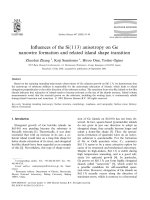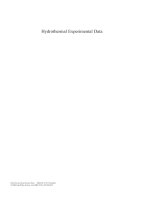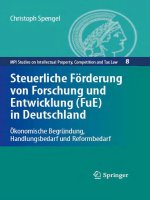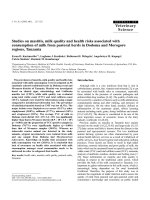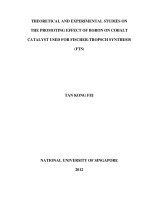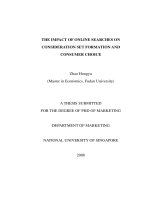Some experimental studies on vortex ring formation and interaction
Bạn đang xem bản rút gọn của tài liệu. Xem và tải ngay bản đầy đủ của tài liệu tại đây (25.41 MB, 209 trang )
SOME EXPERIMENTAL STUDIES ON VORTEX RING
FORMATION AND INTERACTION
DEEPAK ADHIKARI
(B. Eng.(Hons.), NUS)
A THESIS SUBMITTED
FOR THE DEGREE OF MASTER OF ENGINEERING
DEPARTMENT OF MECHANICAL ENGINEERING
NATIONAL UNIVERSITY OF SINGAPORE
2009
Acknowledgements
ACKNOWLEDGEMENTS
I would like to convey my gratitude to my project supervisor, Professor Lim Tee Tai
for his supervision during my time at the Fluid Mechanics Laboratory. It is through
him that I have learnt the art of scientific experimental research and gained much
perspective to approach fundamental problems in fluid mechanics. I am thankful and
deeply indebted to him for his patience and support which he has given me.
I would like to thank Mr. Ramchandra Paudel, who has been like an elder brother to
me. His words of encouragement have always been one of the greatest sources of
inspiration and motivation behind the completion of my work.
I am grateful and thankful to Assistant Professor Teo Chiang Juay, Dr. Lua Kim
Boon, Dr. Cui Yongdong and Mr. Ng Yow Thye for the many constructive and
enriching discussions. I have acquired knowledge in understanding the research world
in fluid mechanics through casual conversations with them.
I would also like to thank the laboratory technologists, Mr. Yap Chin Seng, Mr. Tan
Kim Wah, Mr. Looi Siew Wah and Mr. James Ng Chun Phew for their valuable
help in logistics and manufacturing some of the equipment which I used for my
experiments.
Last, but not least, I would like to thank all others who have helped me in one way or
another during my time at the NUS Fluid Mechanics Laboratory.
i
Table of Contents
TABLE OF CONTENTS
Acknowledgements
(i)
Table of Contents
(ii)
Summary
(iv)
List of Appendices
(vi)
List of Figures
(vii)
List of Tables
(xix)
Nomenclature
(xx)
Chapter 1
Introduction
1.1 Background
1.2 Motivation
1.3 Objectives
1.4 Organization of Thesis
Chapter 2
Literature Review
1
1
5
7
8
9
2.1 Circular Vortex Rings
2.1.1 Formation of a Circular Vortex Ring
2.1.2 Structure of a Circular Vortex Ring
2.1.3 Stability of a Circular Vortex Ring
2.1.4 Turbulent Vortex Ring
10
10
17
22
23
2.2 Elliptic Vortex Rings
2.2.1 Characteristics of an Elliptic Vortex Ring
2.2.2 Elliptic Jets
2.2.3 Other Non-Circular Vortex Rings/Jets
25
25
33
37
2.3 Interaction of a Vortex Ring with a Circular Cylinder
2.3.1 Interaction of Vortex Ring with a Small Cylinder
2.3.2 Cut-and-Reconnection Phenomena
40
40
41
Chapter 3
Experimental Setup & Methodology
47
3.1 Vortex Ring Generator
3.1.1 Tank
3.1.2 Piston-Cylinder Arrangement
3.1.3 Motion Control Mechanism
48
48
49
49
3.2 Test Models
3.2.1 Circular Nozzle
3.2.2 Elliptic Nozzles
3.2.3 Cylinders
3.2.4 Cylinder/Nozzle Fixture
50
50
51
52
53
ii
Table of Contents
3.3 Dye Flow Visualization
55
3.4 Digital Particle Image Velocimetry (DPIV)
3.4.1 Illumination Source
3.4.2 Specifications of Image Acquisition
3.4.3 Synchronization of DPIV System and Motion Control
3.4.4 Seeding Specifications
3.4.5 Image Processing & Data Validation
57
57
57
58
60
60
3.5 Data Post-Processing
3.5.1 Vorticity Field
3.5.2 Dimensions of a Vortex Ring
3.5.3 Trajectory of a Vortex Ring
3.5.4 Circulation of a Vortex Ring
63
65
65
67
67
3.6 Experimental Conditions
69
Chapter 4
Results & Discussion
4.1 Circular Vortex Rings
4.1.1 Formation of the a Circular Vortex Ring
4.1.2 Variables Characterizing Circular Vortex Ring
4.1.3 Core Characteristics of Circular Vortex Ring
4.1.4 Section Summary
71
72
77
80
86
90
4.2 Elliptic Vortex Rings
4.2.1 Trajectory of Elliptic Vortex Rings
4.2.2 Stretching of the Vortex Core
4.2.3 Flow Field of Elliptic Vortex Rings
4.2.4 Effects of Higher Stroke Ratios (LN/DN ≥ 2)
4.2.5 Section Summary
91
101
108
111
115
133
4.3 Interaction of a Vortex Ring with a Circular Cylinder
4.3.1 Cut-and-Reconnection Process
4.3.2 Effects of Varying Stroke Ratio on the Interaction
4.3.3 Section Summary
134
135
151
155
Chapter 5
Conclusion
5.1 Circular Vortex Ring
5.2 Elliptic Vortex Rings
5.3 Interaction of a Vortex Ring with a Circular Cylinder
Chapter 6
References
Recommendations
156
156
157
159
160
161
iii
Summary
SUMMARY
While the study of vortex rings has come a long way in research with myriad of
interesting findings, there are still several areas in the study which have not been fully
understood or explained. This thesis aims to open up some of the issues and provide
experimental investigations in these areas. The experimental techniques used in the
investigations are dye visualization and Digital Particle Image Velocimetry (DPIV).
The current study is divided into three parts: 1. the study of circular vortex rings, 2. the
study of elliptic vortex rings, and 3. the study of interaction of a vortex ring with a
circular cylinder.
In the study of circular vortex rings, relationship between the characteristics of the
vortex rings and the fluid slug is investigated. This includes relating Reynolds number
(based on circulation, ReΓ), the diameter of the ring (D), and the vortex core diameter
(c), with the Reynolds number (based on nozzle diameter, ReN) and the stroke ratio
(LN/DN). Next, the vorticity profile within the vortex core is investigated and found to
be a close fit to a Gaussian function. The variation of this function with Reynolds
numbers (nozzle) and stroke ratios is also presented.
Elliptic vortex rings are studied with nozzles of aspect ratio (AR) 2 and 3. In the
study, the spatial and temporal trajectories of the elliptic vortex rings are investigated
for LN/DN = 1. A deviation of trajectory under some conditions is observed, and this is
attributed to the effect of cross-linking of vortices. Next, the study on the existence of
iv
Summary
core stretching of the elliptic vortex rings is carried out and findings reveal that
stretching does not occur for both aspect ratios (AR = 2 and 3). The flow fields of the
elliptic vortex rings, which reveals some interesting critical nodes upstream of the
vortex ring, are also investigated. Lastly, the effects of high stroke ratios (LN/DN ≥ 2)
on the formation of elliptic vortex rings are examined.
Under this condition,
visualization and DPIV results reveal the existence of vortex pair downstream and
streamwise vortices upstream of the ring. These vortical structures are found to hasten
the azimuthal instability and break down the vortex ring through complex interactions
with the vortex core.
Finally, in the study on the interaction of a circular vortex ring with a circular cylinder,
it is found that the reconnection occurs only at cylinder diameters, dc ≤ 1.32 mm for
LN/DN = 1.
The interpretation of the reconnection mechanism is illustrated and
explained. In the experiment, the behaviour of the vortex ring during the interaction
with cylinders is observed to be insensitive to the Reynolds number (nozzle).
However, for LN/DN ≥ 2, reconnection is observed for cylinder diameter as high as
dc = 1.86 mm. Furthermore, vortex ring of large stroke ratios (LN/DN ≥ 2) reveal a
“von Karman-like” vortex street which eventually interacts with the core of the vortex
ring.
v
List of Appendices
LIST OF APPENDICES
Appendix A: Program to track the coordinates of maximum and minimum
vorticity values from Tecplot data file and determination of
other quantities.
168
Appendix B: Program to calculate the circulation of a region defined by
the relevant coordinates from the Tecplot data file.
172
Appendix C: Visualization and vorticity plots of circular vortex rings for
varying LN/DN.
176
Appendix D: Vorticity plots of elliptic vortex rings for varying ReN, with
LN/DN = 1.
181
Appendix E: Visualization of the interaction of a vortex ring with a
circular cylinder for varying cylinder diameters, dc, and ReN
with LN/DN = 1.
184
vi
List of Figures
LIST OF FIGURES
Figure 2-1:
Formation of a vortex ring (Adhikari, 2007).
10
Figure 2-2:
Graph of Γ/Γslug against LN/DN (adapted from Lim and
Nickels (1995)).
12
Velocity profile of fluid slug from the nozzle exit (a) at
low stroke ratios and (b) at high stroke ratios.
13
Figure 2-4:
Characteristics variables of the a) vortex ring and the b)
fluid slug from ejecting from the nozzle.
18
Figure 2-5:
Core composition of vortex ring.
20
Figure 2-6:
(a) Diagrammatic view showing the entrainment by a
vortex ring of the fluid from upstream. (b) Diagrammatic
view of instantaneous streamlines relative to a moving
vortex ring. (Maxworthy, 1972).
21
Figure 2-7:
Dye visualization of a turbulent vortex ring (Glezer,
1988).
23
Figure 2-8:
Schematic drawing of the trajectory of elliptic vortex ring
in side, plan and perspective view.
26
Figure 2-9:
Time evolution of elliptic vortex ring of AR = 3 (Oshima
et. al., 1988). The third vortex ring from the nozzle shows
the occurrence of partial bifurcation during deformation of
the ring.
31
Perspective view of an elliptic vortex ring with crosslinked vortices (Zhao and Shi, 1997).
32
Figure 2-3:
Figure 2-10:
vii
List of Figures
Figure 2-11:
Pairing mechanism of two elliptic vortex rings (Husain &
Hussain, 1991).
36
Formation of (a) vortex filaments in a jet, which gathers to
form (b) rolls and braids, and subsequently through selfinduced velocity, results in the formation of
(c) streamwise vortices (or ribs) (Husain & Hussain,
1993). The direction of self-induced (SI) and mutually
induced (MI) velocities are labelled.
37
Figure 2-13:
Schematic representation of vortex ring after
interaction with a cylinder (Naitoh et. al., 1995).
41
Figure 2-14:
Cut-and-reconnection mechanism of two anti-parallel
vortex tubes (Melander & Hussain, 1989).
43
Mechanism of vortex reconnection. (a) A simple viscous
cancellation of vorticity, and (b) Detailed mechanism of
the reconnection process with the development of vortex
bridges. Blank arrows indicate the flow direction that
pushes the vortex tubes. Single and double arrows
indicate the rotation of vorticity lines and direction of
vorticity, respectively. Hatched areas show the region of
vorticity calcellation through viscous diffusion.
44
Figure 2-16:
Cut-and-reconnection mechanism when vortex core
interacts with a series of wires (Adhikari and Lim, 2009).
45
Figure 3-1:
Schematic diagram of the vortex ring generator (Plan
view). The CCD camera refers to all cameras that were
used in his experiment.
48
Figure 3-2:
Sectional view of the circular nozzle.
50
Figure 3-3:
Sectional view of the elliptic nozzles of aspect ratios
(a) AR = 2 and (b) AR = 3.
51
Figure 2-12:
its
Figure 2-15:
viii
List of Figures
Diagram of the aluminium cylinder connected at its ends
with thin wires to enable it to be mounted on the Perspex
wall.
52
Figure 3-5:
First angle orthographic and isometric view of the
cylinder/nozzle fixture used for interaction of vortex ring
with cylinders.
54
Figure 3-6:
Data acquisition control network (visualization).
55
Figure 3-7:
Sequence of images showing propagation of vortex ring
from the right side of the image window.
56
Figure 3-8:
Network of motion control system and DPIV system,
together with the experimental setup.
59
An instant of a developed vortex ring (at ReN = 1000 &
LN/DN = 1) visualized using dye.
63
Figure 3-9(b):
An instant of a developed vortex ring (at ReN = 1000 &
LN/DN = 1) visualized using DPIV.
64
Figure 3-10:
Vorticity distribution of the vortex ring for ReN = 1420,
LN/DN = 1 through the core centre. The diameter, D, is
difined as the distance between the two peak vorticity
values. Insert diagram shows the vortex ring and the
dotted lines represent the location where the values were
acquired.
66
Horizontal velocity of the vortex ring for ReN = 1420,
LN/DN = 1 through the core centre. The core diameter, c,
is defined as the distance between the two peak velocity
values. Insert diagram shows the vortex ring and the
dotted lines represent the location where the values were
acquired.
67
Figure 3-4:
Figure 3-9(a):
Figure 3-11:
ix
List of Figures
Figure 3-12:
The dotted points represent the data points taken around
the vortex core in order to calculate the circulation of the
vortex ring.
69
Dye visualization of the formation of a circular vortex ring
at ReN = 1000 and LN/DN = 1.
73
Vorticity field of the formation of a circular vortex ring at
ReN = 1000 and LN/DN = 1. The scales on axes are in mm
and the vorticity contours are in s-1.
74
Instantaneous streamlines of the formation of a circular
vortex ring at ReN = 1000 and LN/DN = 1. The scales on
the axes are in mm.
75
Graph of circulation against time for vortex ring with
ReN = 1000 and LN/DN = 1.
77
Reproduction of graph from figure 2-2 with results of
current experiment. + ReN = 1000, - ReN = 1420,
x ReN = 1740.
78
Vorticity field during the formation of a circular vortex
ring at ReN = 1000 and LN/DN = 4. The scales on axes are
in mm and the vorticity contours are in s-1.
79
Relationship between Reynolds number (circulation) and
Reynolds number (nozzle). ○ LN/DN = 1, □ LN/DN = 2,
∆ LN/DN = 3.
82
Relationship between f1 and the stroke ratio, LN/DN. f1
represents the gradient of the lines in figure 4-7.
82
Figure 4-1:
Figure 4-2:
Figure 4-3:
Figure 4-4:
Figure 4-5:
Figure 4-6:
Figure 4-7:
Figure 4-8:
x
List of Figures
Relationship between dimensionless vortex ring diameter,
D/DN, and the stroke ratio, LN/DN. Result of Maxworthy
(1977) is depicted by broken line (----) while the solid line
(──) represents the current experiment. ◊ ReN = 1000,
□ ReN = 1230, ∆ ReN = 1420,x ReN = 1580, + ReN = 1740.
84
Relationship between core diameter (normalized by nozzle
diameter), c/DN, and Reynolds number (nozzle), ReN for
different stroke ratios, LN/DN.
(○, ─) LN/DN = 1,
84
Figure 4-11:
Relationship between dimensionless core diameter (normalized
by ring diameter, D), c/D, and Reynolds number (nozzle), ReN
for different stroke ratios, LN/DN. (○, ─) LN/DN = 1,
(□, −·) LN/DN = 2, (∆, −−) LN/DN = 3.
86
Figure 4-12:
Vorticity distribution within the core of the vortex ring of
ReN = 1420, LN/DN = 1 with a Gaussian curve-fit. The
figure is taken on the vortex core with positive vorticity
value.
88
Relationship between A (see equation 4-6) and ReN. A
corresponds to the peak vorticity value. (○, ─) LN/DN = 1,
(□, −·) LN/DN = 2, (∆, −−) LN/DN = 3.
89
Relationship between w (see equation 4-6) and ReN. w is
related to the width of the Gaussian vorticity profile.
(○, ─) LN/DN = 1, (□, −·) LN/DN = 2, (∆, −−) LN/DN = 3.
90
Figure 4-15:
Dye visualization of the formation of an elliptic vortex
ring of AR = 2 at ReN = 1000 and LN/DN = 1.
92
Figure 4-16:
Vorticity plot of the formation of a elliptic vortex ring of
AR = 2 at ReN = 1000 and LN/DN = 1 in the x-y plane.
The scales on axes are in mm and the vorticity contour
values are in s-1.
93
Figure 4-9:
Figure 4-10:
(□, −·) LN/DN = 2, (∆, −−) LN/DN = 3.
Figure 4-13:
Figure 4-14:
xi
List of Figures
Figure 4-17:
Vorticity plot of the formation of a elliptic vortex ring of
AR = 2 at ReN = 1000 and LN/DN = 1 in the x-z plane.
The scales on axes are in mm and the vorticity contour
values are in s-1.
94
Schematic view of elliptic vortex ring of AR = 2 in the y-z
plane. The arrows represent the direction of the vortex
lines.
95
Figure 4-19:
Dye visualization of the formation of an elliptic vortex
ring of AR = 3 at ReN = 1000 and LN/DN = 1.
97
Figure 4-20:
Vorticity plot of the formation of an elliptic vortex ring of
AR = 3 at ReN = 1000 and LN/DN = 1. The scales on axes
are in mm and vorticity contour values are in s-1.
98
Vorticity plot of the formation of an elliptic vortex ring of
AR = 3 at ReN = 1000 and LN/DN = 1. The scales on axes
are in mm and vorticity contour values are in s-1.
99
Schematic view of an elliptic vortex ring of (a) AR = 2
and (b) AR = 3 at half-cycle of the oscillation in the y-z
plane. The arrows represent the vortex lines. Shaded
areas represent the cross-linking regions which appear as
vortex pair in vorticity plot at x-z plane.
100
Figure 4-23(a): The spatial trajectory of an elliptic vortex ring with
AR = 2 for all Reynolds number (nozzle). ◊ ReN = 1000,
□ ReN = 1230, ∆ ReN = 1420, x ReN = 1580,
+ ReN = 1740.
104
Figure 4-18:
Figure 4-21:
Figure 4-22:
Figure 4-23(b): The temporal trajectory of an elliptic vortex ring with
AR = 2 for all Reynolds number (nozzle). ◊ ReN = 1000,
□ ReN = 1230, ∆ ReN = 1420, x ReN = 1580,
+ ReN = 1740.
104
xii
List of Figures
Figure 4-24(a): The spatial trajectory of an elliptic vortex ring with
AR = 3 for all Reynolds number (nozzle). ◊ ReN = 1000,
□ ReN = 1230, ∆ ReN = 1420, x ReN = 1580,
+ ReN = 1740.
105
Figure 4-24(b): The temporal trajectory of an elliptic vortex ring with
AR = 3 for all Reynolds number (nozzle). ◊ ReN = 1000,
□ ReN = 1230, ∆ ReN = 1420, x ReN = 1580,
+ ReN = 1740.
105
Vorticity plot of elliptic vortex ring with AR = 3 for
ReN = 1230 in (a) x-y and (b) x-z plane. The scales on
axes are in mm and vorticity contour values are in s-1.
106
Vorticity plot of an elliptic vortex ring with AR = 3 for
ReN = 1420 in (a) x-y and (b) x-z plane. The scales on
axes are in mm and vorticity contour values are in s-1.
107
Schematic view of an elliptic vortex ring of
(a) ReN = 1230 and (b) ReN = 1420 in y-z plane. The
arrows represent the direction of vortex lines.
108
Figure 4-28(a): Temporal variation of peak vorticity value of a vortex ring
for ReN = 1000. ◊ Circular ring, □ AR = 2 (x-y plane),
∆ AR = 2 (x-z plane), x AR = 3 (x-y plane), + AR = 3 (x-z
plane).
110
Figure 4-25:
Figure 4-26:
Figure 4-27:
Figure 4-28(b): Temporal variation of peak vorticity value of a vortex ring
for ReN = 1740. ◊ Circular ring, □ AR = 2 (x-y plane),
∆ AR = 2 (x-z plane), x AR = 3 (x-y plane), + AR = 3 (x-z
plane).
110
Figure 4-29:
Instantaneous streamlines during the formation of a
circular vortex ring at ReN = 1000 & LN/DN = 1. The
scales on the axes are in mm. This figure is reproduced
from figure 4-3.
112
xiii
List of Figures
Figure 4-30:
The instantaneous streamlines of an elliptic vortex ring of
AR = 2. (a) x-y and (b) x-z plane. The scales on axes are
in mm.
113
Figure 4-31:
The instantaneous streamlines of an elliptic vortex ring of
AR = 3. (a) x-y and (b) x-z plane. The scales on axes are
in mm.
114
Figure 4-32:
Evolution of an elliptic vortex ring at ReN = 1740,
LN/DN = 2 (a) AR = 2 and (b) AR = 3.
117
Figure 4-33:
Vorticity field of an elliptic vortex ring of AR = 2,
ReN = 1740 and LN/DN = 2. (a) x-y and (b) x-z plane. The
scales on axes are in mm and the vorticity contours are in
s-1.
118
Vorticity plot of an elliptic vortex ring AR = 3,
ReN = 1740, LN/DN = 2. (a) x-y plane and (b) x-z plane.
The scales on axes are in mm and vorticity contour values
are in s-1.
119
Instantaneous streamlines of an elliptic vortex ring of
AR = 2, ReN = 1740 and LN/DN = 2. (a) x-y and (b) x-z
plane. The scales on axes are in mm.
121
Instantaneous streamlines of an elliptic vortex ring
AR = 3, ReN = 1740, LN/DN = 2. (a) x-y plane and (b) x-z
plane. The scales on axes are in mm.
122
Evolution of an elliptic vortex ring at ReN = 1000,
LN/DN = 3. (a) AR = 2 and (b) AR = 3.
124
Evolution of an elliptic vortex ring at ReN = 1000,
LN/DN = 4. (a) AR = 2 and (b) AR = 3.
125
Evolution of an elliptic vortex ring at ReN = 1000,
LN/DN = 6. (a) AR = 2 and (b) AR = 3.
126
Figure 4-34:
Figure 4-35:
Figure 4-36:
Figure 4-37:
Figure 4-38:
Figure 4-39:
xiv
List of Figures
Figure 4-40:
Interpretation on the development of streamwise vortices
for an elliptic vortex ring of AR = 2, ReN = 1000,
LN/DN = 6.
129
Evolution of an elliptic vortex ring at ReN = 1740,
LN/DN = 6. (a) AR = 2 and (b) AR = 3.
130
Figure 4-42:
Vorticity plot of an elliptic vortex ring of AR = 2,
ReN = 1740 and LN/DN = 6. (a) x-y and (b) x-z plane.
The scales on axes are in mm and the vorticity contour
values are in s-1.
131
Figure 4-43:
Vorticity plot of an elliptic vortex ring of AR = 3,
ReN = 1740 and LN/DN = 6. (a) x-y and (b) x-z plane. The
scales on axes are in mm and the vorticity contour values
are in s-1.
132
Figure 4-44:
Interaction of a vortex ring with a cylinder of dc = 0.18mm
at ReN = 1000 and LN/DN = 1.
137
Figure 4-45:
Interaction of a vortex ring with a cylinder of dc = 0.18mm
at ReN = 1420 and LN/DN = 1.
138
Interaction of a vortex ring with a cylinder of dc = 0.18mm
at ReN = 1740 and LN/DN = 1.
139
Interaction of a vortex ring with a cylinder of dc = 0.39mm
at ReN = 1420 and LN/DN = 1.
140
Author’s interpretation of the cut-and-reconnection
mechanism for a vortex ring interacting with a cylinder.
This mechanism is similar to that reported by Adhikari
and Lim (2009). The arrow heads depict the direction of
141
Figure 4-41:
Figure 4-46:
Figure 4-47:
Figure 4-48:
vorticity on half of the ring that is in the foreground.
xv
List of Figures
Figure 4-49:
Vorticity plot of the interaction of a vortex ring with a
cylinder of dc = 0.18mm at ReN = 1420 and LN/DN = 1.
The scales on axes are in mm and the vorticity contour
values are in s-1.
142
Interaction of a vortex ring with a cylinder of dc = 0.92
mm at ReN = 1420 and LN/DN = 1.
144
Interaction of a vortex ring with a cylinder of dc = 1.32
mm at ReN = 1420 and LN/DN = 1.
146
Vorticity plot of the interaction of a vortex ring with a
cylinder of dc = 1.32 mm at ReN = 1420 and LN/DN = 1.
The scales on axes are in mm and the vorticity contour
values are in s-1.
147
Author’s interpretation of the interaction of a vortex ring
with a cylinder of dc = 1.32 mm at ReN = 1420 and
LN/DN = 1. The induced velocity field, represented by
dotted lines, maintains the structure of vortex ring even
after the interaction with the cylinder. The shaded area
represents the core of the vortex ring.
148
Interaction of a vortex ring with a cylinder of dc = 1.86
mm at ReN = 1420 and LN/DN = 1.
150
Interaction of a vortex ring with a cylinder of dc = 1.86
mm at ReN = 1420 and LN/DN = 2.
152
Figure 4-56:
Interaction of a vortex ring with a cylinder of dc = 1.86
mm at ReN = 1420 and LN/DN = 3.
153
Figure 4-57:
Vorticity plot of the interaction of a vortex ring with a
cylinder of dc = 1.89 mm at ReN = 1420 and LN/DN = 3.
The scales on axes are in mm and the vorticity contour
values are in s-1.
154
Figure 4-50:
Figure 4-51:
Figure 4-52:
Figure 4-53:
Figure 4-54:
Figure 4-55:
xvi
List of Figures
Figure C-1:
The formation of a circular vortex ring at ReN = 1000 and
LN/DN = 2. (a) Dye visualization and (b) vorticity field.
The scales on axes in (b) are in mm and the vorticity
contours are in s-1.
177
The formation of a circular vortex ring at ReN = 1000 and
LN/DN = 3. (a) Dye visualization and (b) vorticity field.
The scales on axes in (b) are in mm and the vorticity
contours are in s-1.
178
The formation of a circular vortex ring at ReN = 1000 and
LN/DN = 4. (a) Dye visualization and (b) vorticity field.
The scales on axes in (b) are in mm and the vorticity
contours are in s-1.
179
The formation of a circular vortex ring at ReN = 1000 and
LN/DN = 5. (a) Dye visualization and (b) vorticity field.
The scales on axes in (b) are in mm and the vorticity
contours are in s-1.
180
Vorticity field of the formation of an elliptic vortex ring of
AR = 3 at ReN = 1580 and LN/DN = 1. (a) x-y plane and
(b) x-z plane. The scales on axes are in mm and the
vorticity contours are in s-1.
182
Vorticity field of the formation of an elliptic vortex ring of
AR = 3 at ReN = 1740 and LN/DN = 1. (a) x-y plane and
(b) x-z plane. The scales on axes are in mm and the
vorticity contours are in s-1.
183
Interaction of a vortex ring with a cylinder of dc = 0.39
mm at (a) ReN = 1420 and (b) ReN = 1740, LN/DN = 1.
185
Interaction of a vortex ring with a cylinder of dc = 0.92
mm at (a) ReN = 1420 and (b) ReN = 1740, LN/DN = 1.
186
Interaction of a vortex ring with a cylinder of dc = 1.32
mm at (a) ReN = 1420 and (b) ReN = 1740, LN/DN = 1.
187
Figure C-2:
Figure C-3:
Figure C-4:
Figure D-1:
Figure D-2:
Figure E-1:
Figure E-2:
Figure E-3:
xvii
List of Figures
Figure E-4:
Interaction of a vortex ring with a cylinder of dc = 1.86
mm at (a) ReN = 1000 and (b) ReN = 1420, LN/DN = 1.
188
xviii
List of Tables
LIST OF TABLES
Table 3-1:
Summary of DPIV image acquisition specification in all the
experiments.
58
Table 3-2:
Summary of the input parameters used for circular and
elliptic vortex rings experiment.
70
Table 3-3:
Summary of the input parameters used for vortex ring
interaction with a cylinder experiment.
70
xix
Nomenclature
NOMENCLATURE
Symbols
c
Core diameter of the vortex ring
D
Diameter of the vortex ring
DN
Inner diameter of the circular nozzle
Do
Outer diameter of the circular nozzle
DP
Diameter of the piston in the piston-cylinder arrangement
dc
Diameter of the cylinder
LN
Length of fluid slug ejected from the nozzle
U
Propagation of the vortex ring
UN
Velocity of fluid slug at the nozzle exit
t
Time of evolution of the vortex ring
Greek Symbols
Γ
Circulation of the vortex ring
λ
Number of azimuthal waves cycles on the vortex ring
ω
Vorticity
ν
Kinematic viscosity
δs
Diameter of the vortex spiral
Terminologies
AR
Aspect ratio
LN/DN
Stroke ratio
ReΓ (=Γ/ν)
Reynolds number (circulation)
ReN (=UNDN/ν)
Reynolds number (nozzle)
t* (=UNt/DN)
Non-dimensional time
xx
Chapter 1 Introduction
Chapter 1
Introduction
1.1
Background
One can easily identify a vortex ring upon observing a smoke ring whether it is ejected
by a smoker, a volcano or from the explosion of an atomic bomb. The vortex ring is
observed to appear as a distinct smoke-filled torus propagating with a certain velocity,
and it undoubtedly possesses some level of aesthetic pleasure. It is also interesting to
note that this visual fascination of vortex rings is not only enjoyed by humans;
Dolphins sometimes generate bubble vortex rings1 so that they can entertain
themselves by playing with these bubble rings. Although the sight of vortex rings is
amusing, it is their complete scientific understanding and application in technology
that serves to be even more fascinating.
The first recorded observation of vortex ring is debatable since it is a common
occurrence in nature. However, its first proper scientific exploration was initiated by
Hermann von Helmholtz through his “laws of vortex motion” during the mid 19th
century. This incipient study of vortex ring was then developed further by William
Thomson (later known as Lord Kelvin), who reasoned the existence of vortex rings
using these laws. This reasoning was later complemented by P.G. Tait, a friend of
Lord Kelvin, by constructing a simple technique to carry out an experiment to
visualize the vortex ring (Eckert, 2006). This was the beginning of the scientific study
1
Unlike the conventional vortex ring, the core of the bubble vortex ring produced by dolphins is mainly
air blown from their blowhole.
1
Chapter 1 Introduction
of vortex rings, and since then, many researchers have worked on its theoretical,
experimental and computational aspects.
Towards the end of the 19th century, the first edition of a book on Hydrodynamics was
published by Sir Horace Lamb (Lamb 6th ed., 1932) where he devoted a section of a
chapter on vortex rings. In that section, he analytically derived the velocity of an
inviscid thin-cored vortex ring and discussed the mutual influences of two or more
rings travelling co-axially. A few years later, one of the most notable and significant
analytical model for vortex ring was formulated. Hill (1894) formulated an analytical
solution representing what is known today as the Hill’s spherical vortex. One of the
characteristics of the Hill’s spherical vortex is that its vorticity is contained within a
sphere, while the vortex still possesses a toroidal shape. This analytical model by Hill
is known to be the most simplistic model of vortex ring to have been formulated and it
is still used today.
In the mid 20th century, a more wholesome contribution on the study of the vortex ring
was published by Batchelor (1967). In his book, Batchelor described the different
experimental techniques for generating vortex rings and reproduced some
experimental work in the literature. He then acknowledged that the deficiency in
studying vortex ring analytically is the ignorance of the core structure of the ring. He
concluded by reasoning that a family of vortex rings can exist theoretically with
different core structure assumptions, and that Hill’s spherical vortex is one such entity.
2
Chapter 1 Introduction
While early and mid 20th century saw mainly analytical models of simplified vortex
rings with inviscid assumptions, it was during the 1970s that the fundamental study of
vortex rings progressed rapidly. During this time, more theoretical and experimental
works on its formation, structure and stability were published (Saffman, 1970, 1978;
Kambe and Takao, 1971; Norbury, 1973; Maxworthy, 1972, 1977; Widnall and
Sullivan, 1973; Moore and Saffman, 1972; Kambe and Oshima, 1975; Didden, 1979;
Pullin, 1979). Furthermore, work on turbulent vortex rings was also initiated during
this period (Maxworthy, 1974).
In the late 20th century, the study on the interactions of vortex rings, the study of noncircular vortex ring and the computational study of vortex ring were initiated (Dhanak
and De Bernardinis, 1981; Nitche and Krasny, 1994; Verzicco and Orlandi, 1994;
Orlandi and Verzicco, 1993; Kiya et. al., 1992; Lim, 1989; Lim and Nickels, 1992). It
was also during this period that significant findings of researchers were compiled and
recorded to give a comprehensive insight on the understanding of vortex rings (Lim
and Nickels, 1995; Saffman, 1992; Shariff and Leonard, 1992).
Since the late 1990s, the study of vortex rings has been carried out to an even greater
depth due to the rapid advancements in technology. With these improvements, some
of the work carried out over the last two decades include: resolving controversial
findings recorded in the past (Lim, 1997(a); Lim, 1997(b)), the generation of vortex
ring with varying boundary conditions (Lim, 1998; Dabiri 2005) and the study on the
optimal formation of vortex ring (Gharib et. al., 1998). A recent review has been
3
Chapter 1 Introduction
published which provides an overview on the optimal formation of vortex ring and its
relation to biological propulsion system (Dabiri, 2009).
Alongside the fundamental study of vortex rings that has progressed this far, its
potential technological application has also been looked into with much interest. One
of its major technological applications is in starting jet flow. Since vortex ring is
regarded as the building block behind the mixing, entrainment, noise generation and
heat transfer of the starting jet flow, understanding vortex rings will eventually enable
suppression or enhancement of these properties (Lim and Nickels, 1995).
Other
potential applications of vortex rings include projecting smoke and other effluents to
high altitudes in atmosphere without the use of tall chimneys (Turner, 1960; Fohl,
1967), underwater drilling (Chahine and Genoux, 1983) and combating fire in oil wells
(Akhmetov et. al., 1980). Recently, vortex ring has been studied for its potential use in
propulsion by drawing inspiration from the bio-locomotion of jellyfish and insect
flights (Dabiri et. al., 2005; Dudley, 1999).
4
